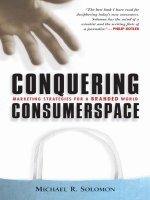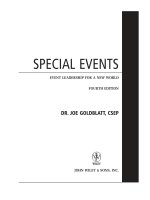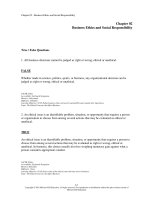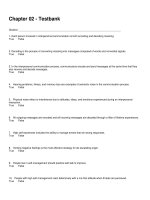Business communication developing leaders for a networked world 2nd edition test bank
Bạn đang xem bản rút gọn của tài liệu. Xem và tải ngay bản đầy đủ của tài liệu tại đây (771.24 KB, 80 trang )
Business Communication Developing Leaders for a Networked
World 2nd Edition Test Bank by Peter Cardon
Solutions Manuals, Instructor's Resource Manual, Answers
key all chapters. download:
Chapter 03
Team Communication and Difficult Conversations
True / False Questions
1. The basic principles of team communication all depend on a strong speaking-centered approach.
True
False
2. Effective teams spend about half their time bonding by talking about social activities.
True
False
3-1
3. When team members experience conflict because they are trying to make sense of competing
ideas about how the team should work, they are in the storming stage of team development.
True
False
4. In best-case scenarios, work teams usually take six to seven weeks to achieve maximum
performance.
True
False
5. High-performing teams go through repeated cycles of disassociation and association.
True
False
6. Sally attends a meeting that focuses on brainstorming how to solve a particular problem. The
agenda is fluid, and the team adjusts the time it spends on various tasks as needed. This is an
example of a coordination meeting.
True
False
7. When developing an agenda to address high-priority items, items of least importance must be
placed near the beginning of the agenda.
True
False
8. Melva perceives that Jonathan, the meeting facilitator, seems to favor one position over others.
As a result, Melva may be reluctant to share her opinions.
True
False
9. Research has shown that teams that have less dissent during meetings reach higher-quality
decisions.
True
False
3-2
10. For brevity, the minutes of a meeting should include only the main decisions that were reached.
True
False
11. One of the unique challenges of working in virtual teams is the inability to gain information by
reading nonverbal cues.
True
False
12. In the current business environment, virtual teams rely primarily on phone calls, teleconferences,
and email to communicate with one another.
True
False
13. One significant advantage of virtual meetings is that team members can multitask during them.
True
False
14. Because virtual teams have a more difficult time building relationships than traditional teams,
experts recommend starting each virtual meeting with social chat.
True
False
15. The most important stage of group writing is the drafting stage.
True
False
16. When producing group writing, it is important to ensure that the writing reflects the views of the
group at every stage—gathering information, drafting initial findings, and editing the final
document.
True
False
17. During group writing projects, it is important not to waste time discussing roles and contributions.
True
False
3-3
18. An absence of conflict during conversations might imply that employees are not voicing their true
perspectives.
True
False
19. In emotionally charged, high-stakes conversations, forcefully stating your message at the
beginning will often lead to productive outcomes.
True
False
20. High self-awareness is crucial for handling difficult conversations successfully.
True
False
Multiple Choice Questions
21. Which of the following describes a team in the forming stage of team development?
A. All four members of the team discuss what the team roles and goals should be.
B. Nick and Julie present alternate ways of assigning work, and the team debates the issue.
C. Nick, Julie, Raul, and Ming take turns sharing their background with the others.
D. The four group members work at their assigned tasks efficiently and work together as needed.
E. Nick and Ming draft a work plan, while Raul and Julie write guidelines for the group to
consider.
3-4
22. Nick, Julie, and Raul each share different ideas about how the team should approach work, and
the team spends some time debating which ideas to adopt. What stage is the team at?
A. norming
B. forming
C. performing
D. storming
E. reforming
23. Which of the following is characteristic of the norming stage of team development?
A. Team members get to know each other and try to gain acceptance.
B. Team members share competing ideas about the task and roles, and conflict occurs.
C. Team members easily manage to reach consensus even when there is conflict.
D. Team members are still uncertain about what is required of them.
E. Team members agree upon mutual goals and individual responsibilities.
24. Which of the following best describes the performing stage of team development?
A. All four members of the team discuss what the team roles and goals should be.
B. Nick and Julie present alternate ways of assigning work, and the team debates the issue.
C. Nick, Julie, Raul, and Ming each share their background at the company.
D. The four group members work at their assigned tasks efficiently and work together as needed.
E. Nick and Ming draft a work plan, while Raul and Julie write guidelines for the group to
consider.
3-5
25. Teams rapidly develop shared perceptions and commitment during the _____ stage of team
development.
A. norming
B. forming
C. performing
D. storming
E. reforming
26. Erik is a manager who organizes his department into teams at the beginning of September. By
December, he worries because the teams are still having conflict and do not seem very
productive. What would be the best advice to give Erik?
A. Conclude that his workers are not team-oriented people. Abandon the experiment before work
falls further behind.
B. Be patient because the teams are in the storming stage. Give them time to reach the norming
and performing stages.
C. Conclude that he made a mistake in the makeup of the teams. Reassign people to new teams
and start over.
D. Be patient because the teams are in the norming stage. Give them time to reach the more
productive performing stage.
E. Conclude that the teams are spending too little time on work. Start to sit in meetings and direct
activities.
27. Which of the following is characteristic of members from high-performing teams?
A. They view conflict as unhealthy and counterproductive.
B. They approach work with a judgmental mind-set.
C. They openly discuss the set of values, norms, and goals they share.
D. They make fewer work-related and supportive statements than other groups.
E. They meet infrequently, preferring to work as individual units.
3-6
28. Whenever he has to present a proposal to his managers, LeRoy is able to distance himself from
his ideas and accept criticism without becoming defensive. What process enables LeRoy to do
this?
A. consolidation
B. association
C. disassociation
D. formation
E. reflection
29. _____ is the psychological bonding that occurs between people and their ideas.
A. Consolidation
B. Association
C. Disassociation
D. Formation
E. Reflection
30. Which of the following is true of high-performing teams?
A. They remain professional and avoid social bonding or personal connection.
B. They see differences of opinion as signs of dysfunction in the team.
C. They spend most of their time discussing work-related issues.
D. They do not meet frequently to discuss their purposes because it wastes time.
E. They have a homogenous rather than a diverse membership.
3-7
31. Which of the following is a trait that contributes to the inherent diversity of a team?
A. members with customer service experience
B. members with retail experience
C. members with engineering experience
D. members with managerial experience
E. members with a variety of ethnic backgrounds
32. What impact does 2-D diversity have on a company?
A. The company is more likely to increase its market share.
B. The company is more likely to experience damaging conflict.
C. The company is less likely to have a "speak-up culture."
D. The company is less likely to have access to a variety of perspectives.
E. The company is more likely to suffer significant financial losses.
33. Which of the following is the role of a facilitator?
A. keeping the meeting's minutes
B. ensuring fair discussion of each agenda item in a meeting
C. discouraging debate and dissent
D. steering conversations toward predetermined conclusions
E. presenting counter arguments to ideas or suggestions
34. Abdul is frustrated because his team members come unprepared for meetings. What is the first
thing he should do to try to improve the situation?
A. distribute minutes after the previous meeting to remind people of what was covered
B. distribute an agenda ahead of the meeting so people know what to expect
C. distribute homework assignments several days before each meeting
D. criticize people during the meeting if they are not contributing enough
E. criticize people after the meeting to make his point without embarrassing them
3-8
35. Moira has a standard way of running meetings that she has used for a long time. Her meetings
tend to be efficient but dry, and people have difficulty feeling engaged. Which of the following
techniques should Moira use to solve that problem?
A. distribute an agenda ahead of time
B. have someone take minutes and distribute them afterward
C. make sure to start and end the meeting on time
D. encourage each person to share his or her opinion
E. remain neutral while facilitating the discussion
36. Which of the following would be the most productive time to schedule a meeting?
A. 2:00 p.m. Thursday
B. 4:00 p.m. Wednesday
C. 10:00 a.m. Tuesday
D. Noon Monday
E. 10:00 a.m. Friday
37. What is a recommended method of planning thoroughly for meetings?
A. reviewing the minutes of the last meeting to see what was left unfinished
B. calling everyone together and working out an agenda as a group
C. using the agenda of the last meeting as a model for running the next meeting
D. taking ten minutes before the meeting starts to prepare a few action items
E. asking yourself essential questions about purpose, strategy, scheduling, and coordination
3-9
38. In which of the following situations is a company most likely to need a series of problem-solving
meetings that have no preset agenda?
A. planning the annual picnic
B. deciding the work assignments for a project
C. developing a new product proposal
D. discussing the transition to new ownership
E. reviewing a market research report
39. A catering company has a weekly meeting. Every week, the meeting starts with a story about how
the caterer's food helped make an occasion special for the people who were there. What is the
most likely reason for this tradition?
A. to help the employees open up to each other
B. to help the employees bond since they work on scattered jobs
C. to deal with the most important agenda items first
D. to illustrate an important aspect of teamwork
E. to remind the employees of the company's customer focus
40. Oscar starts his meetings by describing the procedures he wants people to follow while taking
part in the discussion and explaining what topics must be kept confidential. By doing this, Oscar
is providing
A. agenda items.
B. minutes.
C. consensus.
D. ground rules.
E. action items.
3-10
41. What should the leader do just before closing a meeting?
A. summarize what was accomplished
B. allow the attendees to ask questions
C. elaborate on the main issues
D. ask each attendee to share
E. evaluate his or her performance
42. Team leader Sean always follows through after meetings by asking all the participants how they
are doing with their assigned action items. What effect is this likely to have on the other team
members?
A. They will feel that the meeting was a waste of time.
B. They will perceive the team decisions as important.
C. They will feel that Sean views them as children.
D. They will be less likely to attend the next meeting.
E. They will procrastinate because they resent being nagged.
43. Which of the following is a reason that organizations use virtual teams?
A. to reduce isolation
B. to resolve conflict more easily
C. to encourage sharing of opinions
D. to save money
E. to avoid time zone differences
3-11
44. Which action is most likely to help build trust in a virtual team?
A. be proactively engaged
B. multitask during meetings
C. avoid social conversation
D. work as independently as possible
E. rely mostly on email to communicate
45. David has just been appointed leader of a new virtual team. He senses that the team members
have doubts about each other's competence. What can he do to alleviate this situation?
A. take time during a meeting to review the company's mission statement
B. encourage the team members to consider stakeholders in every discussion
C. allow team members to choose the people they want to work with more closely
D. schedule a time when people can share their professional accomplishments
E. establish ground rules for their meetings from the very beginning
46. Which stage of team development do virtual teams sometimes skip?
A. forming
B. storming
C. norming
D. performing
E. reforming
47. What is a virtual watercooler?
A. a virtual place to record team goals, assignments, and projects
B. a social media space where virtual team members can interact spontaneously
C. a database of all the agendas and minutes from a virtual team's meetings
D. a social collaboration tool that allows virtual team members to work together easily
E. a virtual collaboration tool that adjusts for time zone and language differences
3-12
48. Which of the following practices helps to increase buy-in from virtual meeting participants?
A. running the meeting efficiently
B. multitasking during meetings
C. taking minutes in real time
D. opening with a contentious question
E. preparing how to state views ahead of time
49. Jamila is concerned that her virtual teammates are misinterpreting each other's statements
because they cannot see facial expressions and gestures. Which of the following possible
solutions should Jamila suggest to her team leader?
A. setting up a virtual watercooler
B. opening with a contentious question
C. taking minutes in real time
D. asking team members to avoid multitasking
E. using video during the meetings
50. What impact does it have on long-term virtual teams when they meet in person?
A. They are more likely to start having conflicts.
B. They find it easier to build rapport.
C. They take longer to trust each other.
D. They often split into separate factions.
E. They waste more time on social chat.
3-13
51. What do professionals identify as the number one challenge of working in virtual teams?
A. the need to make decisions too quickly
B. unclear decision-making rules
C. not enough time to build relationships
D. differing leadership styles
E. lack of participation
52. Lana's team has been given a group writing assignment. The deadline is two months away.
When should the group start working on the project?
A. a week before the deadline
B. two weeks before the deadline
C. in a month
D. in two weeks
E. right away
53. Hector and his team work for an educational publisher. The team has to write a report comparing
the textbooks of three competitors. Who would be the best person to analyze the books' methods
of teaching?
A. Hector, who has two years of experience in market research
B. George, who has five years of experience as an editor
C. Kerry, who has three years of experience as a book designer
D. Lin, who has four years of experience as an educator
E. Lisa, who has five years of experience as a production coordinator
3-14
54. Janet's team is working on a group document, which they store in an FTP system on the
company server. On Friday, Claire and Malik download the document at the same time, and each
makes edits. Malik uploads his document first. When Claire uploads her copy of the document,
she erases all of Malik's work. What went wrong?
A. Team members did not use the same word processing program.
B. The team did not assign its members clear responsibilities.
C. The team did not have a system to handle version control.
D. Team members were not clear about the purpose of the revision.
E. The team did not consider the needs of the audience.
55. Hector and his team work for an educational publisher. The team has to write a report comparing
the textbooks of three competitors. Who would be the best person to polish the final version of
their report so it has a consistent voice?
A. Hector, who has two years of experience in market research
B. George, who has five years of experience as an editor
C. Kerry, who has three years of experience as a book designer
D. Lin, who has four years of experience as an educator
E. Lisa, who has five years of experience as a production coordinator
56. Barb's team has to write a report recommending three healthcare plans to offer the company's
employees next year. At the planning meeting, each person is assigned responsibilities. Which of
the following team members is not carrying a fair share of the group's work?
A. Barb, Jaime, and Kat will each research several healthcare plans for the team to evaluate.
B. Elena will create all of the charts, graphs, and tables needed for the final report.
C. Meghan will take minutes at the meetings and use them to create a first draft of the report.
D. Amy will send out reminders of the meetings and take attendance.
E. Michael will edit the report until the team agrees it is polished enough to distribute.
3-15
57. When editing a group document, what should be the first thing the team works on?
A. whether the paper is organized logically
B. the transitions between sections
C. whether the main ideas are strong and clear
D. whether the word choices are appropriate
E. the correctness of the grammar and mechanics
58. After Karla's team completed the first draft of its group document, the team asked her to edit it
carefully for grammar, punctuation, and spelling. At the next meeting, the group decided one
section of the document was not relevant and deleted it. Karla was upset about her wasted work.
What did the team do wrong?
A. It did not establish a system for version control.
B. It did not agree on rules for overwriting one another's work.
C. It did not set up guidelines for using comments and track changes.
D. It did not choose a single person to do the final edit.
E. It did not choose an appropriate purpose for each round of revision.
59. A learning stance implies that
A. you have nothing to learn from the other people involved in the conversation.
B. you intend to find contradictions in what other people have said or done.
C. you avoid difficult conversations in order not to hurt the feelings of other people.
D. you are committed to understanding other peoples' versions of interpersonal interactions.
E. you intend to agree and comply with everything that the speaker says.
3-16
60. Difficult conversations can be handled successfully by
A. hearing everybody's story.
B. agreeing with everything you hear.
C. using the either/or approach.
D. invalidating the perspective of other people.
E. adopting a judgmental stance.
61. What does validating someone entail?
A. recognizing their feelings as legitimate
B. refusing to have difficult conversations with them
C. agreeing unconditionally with their perspectives and views
D. leading them around to your way of thinking
E. deciding to comply with their requests in advance
62. Which of the following makes comments sound more conciliatory and less accusing?
A. I-statements
B. You-statements
C. He-or-she-statements
D. It-statements
E. They-statements
63. Which of the following statements is an example of disagreeing diplomatically?
A. You always interrupt me when I try to explain my reasons.
B. Your methods never work, but you refuse to give mine a chance.
C. I know I'm right about this, and I can prove it to you.
D. This is an issue of policy, not personal interpretation.
E. I feel that I was not given a chance to explain my actions.
3-17
64. Which of the following is the best opening for a difficult conversation?
A. We need to discuss the way you let your team members down on the last project.
B. I really want to understand what went wrong and find a solution we both can accept.
C. Your work has suffered lately, and I want to make some suggestions for improvement.
D. What were you thinking when you made that proposal in the group meeting?
E. You have been demonstrating a bad attitude lately, and I would like to know why.
65. During emotionally charged conversations, the participants should try to
A. oversimplify their approach.
B. find common ground.
C. exaggerate their points.
D. cast situations in either-or terms.
E. evaluate the other person's motives.
Essay Questions
66. Briefly explain the four stages of team formation.
3-18
67. List the traits of effective teams.
68. What is the purpose of an agenda, and how does it relate to effective meetings?
69. How should a leader who wants a high-performing team view dissent in meetings? Explain.
3-19
70. What are at least three ways to build team rapport on virtual teams?
71. What are actions that will help foster trust during the norming stage of a virtual team project?
72. What are some of the roles that team members might be assigned in a group writing project?
3-20
73. During a group writing project, what should teams do to ensure that all team members buy into
the final product? Identify actions to take during all stages of the project.
74. What are the advantages of adopting a learning stance?
75. Why is disagreeing diplomatically an important component of managing difficult conversations?
3-21
Chapter 03 Team Communication and Difficult Conversations Answer
Key
True / False Questions
1.
The basic principles of team communication all depend on a strong speaking-centered
approach.
FALSE
Teams perform far better if they follow the basic principles of team communication, all of which
depend on a strong listening-centered approach.
AACSB: Communication
Accessibility: Keyboard Navigation
Blooms: Remember
Difficulty: 1 Easy
Learning Objective: 03-01 Explain the principles of team communication in high-performing teams.
Topic: Principles of Effective Team Communications
2.
Effective teams spend about half their time bonding by talking about social activities.
FALSE
Teams should focus first and foremost on performance. Sixty to seventy percent of all
comments made in high-performing groups directly relate to work.
AACSB: Teamwork
Accessibility: Keyboard Navigation
Blooms: Understand
Difficulty: 2 Medium
Learning Objective: 03-01 Explain the principles of team communication in high-performing teams.
Topic: Principles of Effective Team Communications
3-22
3.
When team members experience conflict because they are trying to make sense of competing
ideas about how the team should work, they are in the storming stage of team development.
TRUE
In the storming stage, team members open up with their competing ideas about how the team
should approach work. This stage is typically the least productive, since team members are
attempting to make sense of uncertain roles, goals, and priorities.
AACSB: Teamwork
Accessibility: Keyboard Navigation
Blooms: Understand
Difficulty: 2 Medium
Learning Objective: 03-01 Explain the principles of team communication in high-performing teams.
Topic: Principles of Effective Team Communications
4.
In best-case scenarios, work teams usually take six to seven weeks to achieve maximum
performance.
FALSE
Teams go through four natural stages to reach high performance. In best-case scenarios,
work teams take roughly six to seven months to reach this level.
AACSB: Teamwork
Accessibility: Keyboard Navigation
Blooms: Remember
Difficulty: 1 Easy
Learning Objective: 03-01 Explain the principles of team communication in high-performing teams.
Topic: Principles of Effective Team Communications
3-23
5.
High-performing teams go through repeated cycles of disassociation and association.
TRUE
High-performing teams go through repeated cycles of disassociation and association. They
suspend attachment to ideas in the initial discussion phase and then attach themselves to
ideas as they commit to mutually developed goals and related action items.
AACSB: Teamwork
Accessibility: Keyboard Navigation
Blooms: Remember
Difficulty: 1 Easy
Learning Objective: 03-01 Explain the principles of team communication in high-performing teams.
Topic: Principles of Effective Team Communications
6.
Sally attends a meeting that focuses on brainstorming how to solve a particular problem. The
agenda is fluid, and the team adjusts the time it spends on various tasks as needed. This is an
example of a coordination meeting.
FALSE
Coordination meetings primarily focus on discussing roles, goals, and accountabilities.
Coordination meetings typically include many agenda items with a reasonable expectation of
accomplishing each item in the allocated time. What Sally attended was a problem-solving
meeting, which typically involves more fluid issues that are less easily classified as discrete
agenda items and less easily given time allotments.
AACSB: Communication
Accessibility: Keyboard Navigation
Blooms: Understand
Difficulty: 2 Medium
Learning Objective: 03-02 Describe and demonstrate approaches to planning; running; and following up on meetings.
Topic: Managing Meetings
3-24
7.
When developing an agenda to address high-priority items, items of least importance must be
placed near the beginning of the agenda.
FALSE
As you develop the agenda, pay attention to the ordering of items so that it flows much like
you would expect other written communications to flow from point to point. Also, consider
placing the most important agenda items near the beginning. This way, if items take longer
than expected and you are forced to shelve some items, you have addressed those of most
importance.
AACSB: Communication
Accessibility: Keyboard Navigation
Blooms: Remember
Difficulty: 1 Easy
Learning Objective: 03-02 Describe and demonstrate approaches to planning; running; and following up on meetings.
Topic: Managing Meetings
8.
Melva perceives that Jonathan, the meeting facilitator, seems to favor one position over
others. As a result, Melva may be reluctant to share her opinions.
TRUE
A facilitator acts from a neutral position to get each person to participate in a conversation and
ensure that each agenda item is properly discussed. The issue of neutrality for facilitating is
critical. If others view the facilitator as predisposed toward certain positions or perspectives,
they are less likely to express their real thoughts.
AACSB: Communication
Accessibility: Keyboard Navigation
Blooms: Understand
Difficulty: 2 Medium
Learning Objective: 03-02 Describe and demonstrate approaches to planning; running; and following up on meetings.
Topic: Managing Meetings
3-25









